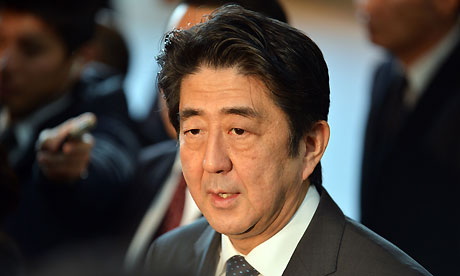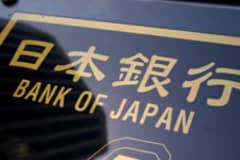Bloomberg News columnist William Pesek has added to the increasing skepticism about the policies of Prime Minister Shinzo Abe to revive the stagnant and ailing Japan economy.
When shall real substantial and bold structural reforms be pushed, so that Asia's second biggest economy can be saved, in order for the future and long-term stability of Asia and the world to become better?
(This image below sourced from fedupusa.org)

(Image of Prime Minister Shinzo Abe below sourced from guardian.co.uk)

(Image below sourced from cnbc.com)

(Image below sourced from politicallyillustrated.com)

Here is the thought-provoking analysis of William Pesek of Bloomberg News:
When shall real substantial and bold structural reforms be pushed, so that Asia's second biggest economy can be saved, in order for the future and long-term stability of Asia and the world to become better?
(This image below sourced from fedupusa.org)

(Image of Prime Minister Shinzo Abe below sourced from guardian.co.uk)

(Image below sourced from cnbc.com)

(Image below sourced from politicallyillustrated.com)

Here is the thought-provoking analysis of William Pesek of Bloomberg News:
Paul Krugman’s Worn-Out Ideas for Japan
Let’s get over this honeymoon for Japan’s new prime minister, Shinzo Abe, and do a reality check on his idea that the economy is about to boom now that voters have returned him to office.
At first, I wondered if I had lost my bearings. Was I just hopelessly cynical after 11 years in Tokyo, watching a numbing parade of inept leaders come and go as the Liberal Democratic Party pledged change that never arrived? The steps Abe has taken in the first few weeks of his latest premiership restored my faith in the merits of skepticism.
Those numbers are hard to ignore on two scores. First, I only hope that those in charge of managing my retirement accounts aren’t among the Japan-bulls-come-lately. The second is how short memories can be. Abe, remember, failed miserably in his first term as prime minister in 2006-2007.
That image takes on a deeper meaning when you consider Japan’s awful demographics and the dearth of ideas to cope with them. Take Finance Minister Taro Aso, who this week said elderly people should “hurry up and die” to relieve pressure on the government to pay for health care.
So is it really plausible that with just one more try of the same old remedies, Abe’s team will get the economy to walk on its own and then sprint ahead? Seriously?
No economist could formulate a credible list of every shot of stimulus and every dose of monetary steroids that officials have pumped into the economy since the early 1990s. There have been too many overlapping treatments to document. None of them, not a single one, achieved what investors are betting Abe will do this time: make a Japanese recovery self-sustaining.
This gambit may fool some investors, and it even got a plug from Nobel-winning economist Paul Krugman. It is true that Japan probably will get a quick GDP jolt. The yen is down and stocks are up. Japanese have seen this movie before, though, and suffered through sequel after sequel.
Abe isn’t offering anything new. Aside from a weaker yen, does he have a plan to make Japan more competitive to take on China or halt Sony Corp.’s slide toward irrelevance? How about ideas to make the labor force more flexible and international, starting with a new immigration policy? Or a strategy that inspires young Japanese to start new companies or families? What about freer trade? Increasing women’s role in politics and business? Even an energy plan that champions something other than the nuclear reactors Japanese fear amid earthquake risks? ]
None of the above. What Abe’s party fails to grasp is that Japan’s challenge is structural, not financial.
Surely that’s the message BOJ Governor Masaaki Shirakawa was aiming for this week. Abe talked about browbeating the central bank into a 2 percent inflation target. Shirakawa’s response? Yeah, maybe in a year. By then, Abe will have replaced Shirakawa, whose term expires in April, with a more agreeable official. But the BOJ’s smackdown is a reminder that monetary policy only goes so far when an economy is hobbled by dysfunction.
The LDP’s policies are like a religion with a fixed set of beliefs that have little utility in today’s world. The party’s dogma was fine before 1964, the year the Tokyo Olympics wowed a world that thought Japan couldn’t rise so quickly from the wreckage of World War II. The policy obsolescence became obvious once the bubble economy of the 1980s crashed.
Things are changing all around Japan. Yet officials in Tokyo refuse to embrace the world of 2013, assuming that the canon that delivered Japan the highest per-capita incomes in Asia is still viable. This faith that Japan is just one huge spending package away from bliss is becoming more detrimental with each passing year and credit downgrade. Abenomics really is more religion than reality.
At first, I wondered if I had lost my bearings. Was I just hopelessly cynical after 11 years in Tokyo, watching a numbing parade of inept leaders come and go as the Liberal Democratic Party pledged change that never arrived? The steps Abe has taken in the first few weeks of his latest premiership restored my faith in the merits of skepticism.
Those numbers are hard to ignore on two scores. First, I only hope that those in charge of managing my retirement accounts aren’t among the Japan-bulls-come-lately. The second is how short memories can be. Abe, remember, failed miserably in his first term as prime minister in 2006-2007.
Walker Economy
Abe’s LDP spent almost 20 years building bridges, roads, tunnels, dams and airports to nowhere and forcing the central bank to add liquidity to the banking system to end deflation. And what did those unimaginative policies leave Japan’s 126 million people with? The easy answer is the world’s highest ratio of debt to gross domestic product. The harder one: Japan has become a nation that can’t proceed without the economic equivalent of a walker.That image takes on a deeper meaning when you consider Japan’s awful demographics and the dearth of ideas to cope with them. Take Finance Minister Taro Aso, who this week said elderly people should “hurry up and die” to relieve pressure on the government to pay for health care.
So is it really plausible that with just one more try of the same old remedies, Abe’s team will get the economy to walk on its own and then sprint ahead? Seriously?
No economist could formulate a credible list of every shot of stimulus and every dose of monetary steroids that officials have pumped into the economy since the early 1990s. There have been too many overlapping treatments to document. None of them, not a single one, achieved what investors are betting Abe will do this time: make a Japanese recovery self-sustaining.
Fooling Investors
Deflation won’t end until Japanese consumers believe it will. Companies won’t hire until they think households will boost spending. Banks won’t lend until they assume loans won’t go bad. Wages won’t rise, supporting the expectations of these three pillars of the economy, until there is genuine confidence that 2013 or 2014 will be better than 2012.This gambit may fool some investors, and it even got a plug from Nobel-winning economist Paul Krugman. It is true that Japan probably will get a quick GDP jolt. The yen is down and stocks are up. Japanese have seen this movie before, though, and suffered through sequel after sequel.
Abe isn’t offering anything new. Aside from a weaker yen, does he have a plan to make Japan more competitive to take on China or halt Sony Corp.’s slide toward irrelevance? How about ideas to make the labor force more flexible and international, starting with a new immigration policy? Or a strategy that inspires young Japanese to start new companies or families? What about freer trade? Increasing women’s role in politics and business? Even an energy plan that champions something other than the nuclear reactors Japanese fear amid earthquake risks? ]
None of the above. What Abe’s party fails to grasp is that Japan’s challenge is structural, not financial.
Surely that’s the message BOJ Governor Masaaki Shirakawa was aiming for this week. Abe talked about browbeating the central bank into a 2 percent inflation target. Shirakawa’s response? Yeah, maybe in a year. By then, Abe will have replaced Shirakawa, whose term expires in April, with a more agreeable official. But the BOJ’s smackdown is a reminder that monetary policy only goes so far when an economy is hobbled by dysfunction.
The LDP’s policies are like a religion with a fixed set of beliefs that have little utility in today’s world. The party’s dogma was fine before 1964, the year the Tokyo Olympics wowed a world that thought Japan couldn’t rise so quickly from the wreckage of World War II. The policy obsolescence became obvious once the bubble economy of the 1980s crashed.
Things are changing all around Japan. Yet officials in Tokyo refuse to embrace the world of 2013, assuming that the canon that delivered Japan the highest per-capita incomes in Asia is still viable. This faith that Japan is just one huge spending package away from bliss is becoming more detrimental with each passing year and credit downgrade. Abenomics really is more religion than reality.

No comments:
Post a Comment